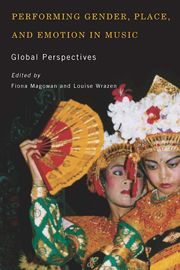Afterword
Published online by Cambridge University Press: 05 December 2013
Summary
The triple themes of Performing Gender, Place, and Emotion in Music demonstrate how important it is to see the connectedness of different concepts of embodiment. These culturally variable terms of physicality and spirituality reach both inwardly toward the most intimate of human sensations or emotion and outwardly to larger environments of place and space. These studies demonstrate how social mediation occurs in relation to each of the three concepts, shaping behaviors and expectations of how music, among other things, both represents and constitutes the ways that we are embodied, emplaced, and “emotioned.”
These chapters evoked memories and stories from my own work. In Canadian studies, I had at one point become interested in assertions about the gender of the nation-state as well as its provinces or regions. I thought of various contested but evocative images, including a number of nineteenth-century political cartoons depicting Canada as the demure maiden next to a matronly woman representing Britain, for instance (unlike the masculinist Uncle Sam imagery of the United States). I recalled Elspeth Probyn's argument that Quebec's mode of “outside belonging” positions it as gay within Canadian identity constructs, an argument that challenges the heterosexist “broken marriage” imagery that she saw in the prereferendum period of the early 1990s. Ian McKay's contention that Nova Scotia was imaged in the mid-twentieth century as a region of hardy males whose realm was the sea also came to mind. These images and interpretations are arguably strategic and intentional assertions—not necessarily discursive formations that are culturally reinscribed and shared by large numbers of people.
- Type
- Chapter
- Information
- Performing Gender, Place, and Emotion in MusicGlobal Perspectives, pp. 185 - 194Publisher: Boydell & BrewerPrint publication year: 2013

